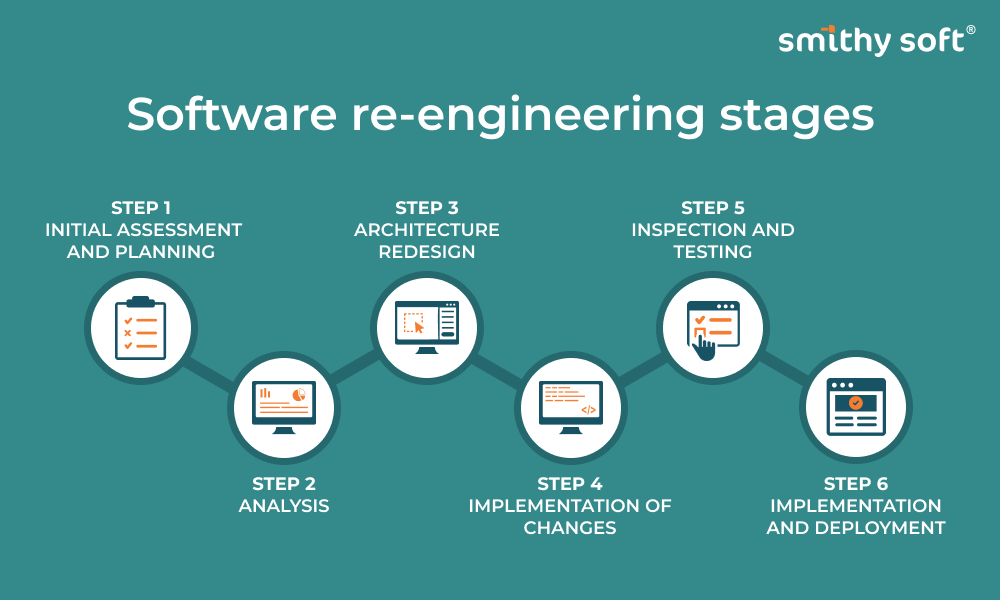Unlocking Growth with Software Re-engineering: Key Benefits and Process

Even if you once had “the best software of the decade”, it’s clearly not enough these days. In the modern technological world that is rapidly developing, there is a need for constant improvement, renewal, modernization, and transformation. Does this mean that everything old should be thrown away and start all over again? No. You just need to apply for re-engineering. And this is something we can help you with!
When do you need to think about the change?
If your business isn’t performing well, or if your competitors are superior to you technically, or if your product lacks certain features, you may need to change.
If users have a hard time using your product because it's too complex, doesn't work well, is not inclusive enough, or is incompatible with other software, etc.
When you discover that your systems are outdated, difficult to integrate with modern tools, don’t support new functions and devices, and are incompatible with successful third-party applications.
When your software product is vulnerable to cyber threats, viruses, breaches, or leaks of customer information, etc.
As operating costs and maintenance costs increase, problems arise with obtaining technical support due to outdated technology.
These are the indicators that you need software modernization and re-engineering.
What is Software Re-engineering?
Design, development, testing, maintenance, and deployment of a software product is the process of software engineering. That is, these are all the stages the software goes through before it is launched for customers and users.
Re-engineering is the process of updating the software. This process adding or changing software features to enhance performance and remove bugs. Re-engineering also implies that the software product will have improved maintainability.
Software re-engineering is different from other development processes, like new development or maintenance. New development involves creating software from scratch. Maintenance focuses on bug fixes and minor updates. At the same time, re-engineering focuses on the transformation and optimization of existing software. It uses the foundation of an already working system, giving it new life through transformation.
So, re-engineering is a way of constantly improving software for better development to meet current and future needs.
Types of Re-engineering
There are four types of re-engineering: re-platforming, refactoring, restructuring, and complete system replacement. Let’s look at each of them closely.
The first type, re-platforming, is moving from on-premises to cloud solutions to improve performance. Or moving to another platform or environment.
Another type is refactoring. It involves making small changes to an existing codebase. This can help with its readability, maintainability, or performance. This revamping is cost-effective and on the risk-free side. But remember that it may not address deeper architectural or functional issues.
Restructuring focuses on modifying a system’s architecture or design. If there are issues with scalability, serviceability, or performance, or you just want to boost them then this re-engineering is for you. It involves significant changes to the system structure and can address architectural issues unlike the previous one. At the same time, restructuring can be more time-consuming and complex than refactoring.
Complete System Replacement is about creating a new system from scratch. This provides a more radical overhaul and modernization but carries higher risks and costs (both time and money).
Software Re-engineering Stages

Software re-engineering is a methodical process that includes several vital steps, each of which is tailored to the unique needs and tasks of specific projects. Here is a general sequence of steps that can be adapted to meet the requirements of various re-engineering goals:
- Initial assessment and planning
Define the goals and objectives of the re-engineering project here. These should include improving performance, improving functionality, or addressing security issues. Determine the needed resources, such as personnel, tools, and budget. Also, outline the scope of work and success metrics, like performance benchmarks or user satisfaction level.
- Analysis
This stage involves understanding the existing system through documentation, research, and stakeholder interviews. Find any issues, weak points, inefficiencies, security risks, or outdated components in the system. It is crucial to understand how the system works and to gather updated requirements from stakeholders and users to ensure the re-engineering process aligns with current needs.
- Architecture redesign
This is the development of a new system architecture or the restructuring of the existing system to solve identified problems and comply with updated requirements. Identify components that need to be modified, improved, or replaced. And create detailed project specifications describing the architecture, components, interfaces, and new system's functionality.
- Implementation of changes
Make changes to the code based on the redesign, which may include refactoring, rewriting, or integrating new components. Consider creating prototypes or mockups beforehand to test your new design and gather feedback.
- Inspection and testing
This step is critical to verify that the upgraded system supports all the original features and meets the new requirements. It is important to conduct various tests. For example, unit testing tests individual components to ensure that they function properly and meet specifications. Integration testing allows you to make sure that the redesigned components work flawlessly in the system. And system testing examines the entire system to verify its functionality, performance, and compliance. User Acceptance Testing is also important, as it checks how well the updated system meets the needs and expectations of the users.
- Implementation and deployment
This is the final phase of the upgrade, which involves a gradual rollout of the updated system to minimize disruptions and get user feedback. Training and support are provided to users and support staff to ensure a smooth transition, while continuous monitoring and maintenance is provided to identify and resolve ongoing issues quickly.
Three Phases of Software Re-engineering
In general, the software re-engineering process is conditionally divided into three main phases:
І. Reverse engineering
This phase should provide a complete understanding of the existing software system. Developers study the source code, documentation, and other resources to understand how the software works. They analyze the code structure, algorithms, and patterns used in the system. They also study design documents, review the intended functionality of the system, and analyze system behavior, data flow, and interaction with external components.
ІІ. Restructuring
The second phase aims to optimize the software system's structure and make it more efficient, flexible, and easy to maintain. It eliminates identified shortcomings and prepares the system for future improvements. It may include code refactoring, improving system architecture, removing obsolete code, etc.
ІІІ. Forward Engineering
It uses the knowledge gained from reverse engineering and improvements to create an improved version of the software. This phase includes adding new or updated components, and features, and testing the software.
This phase ends with a new version of the software that incorporates reverse engineering and restructuring improvements. The updated software is now ready for deployment and use.
Software Re-engineering Problems
Although software re-engineering can improve existing systems, it is not without problems.
One of the main challenges is change management. Re-engineering often involves major modifications to software processes, architecture, and work. This can cause resistance if the changes are not properly communicated or cause big changes in the work process.
Lack of necessary documentation, raw data, and the mismatch of tasks and goals can make re-engineering difficult.
In addition, re-engineering can face budget and time constraints, especially in organizations with limited resources. Justifying the required investment is a challenge.
It can be challenging to ensure data integrity and functionality when dealing with legacy systems. Especially if the technology is outdated or there's poor documentation.
To solve these problems, organizations first establish clear governance to oversee the re-engineering process, goals, priorities, and resources. They must also maintain communication and take a step-by-step approach prioritizing improvements in a reasonable and incremental way.
However, the experience and expertise of the team that will carry out the re-engineering is undoubtedly decisive. Therefore, we advise you to cooperate with professionals in their field who know where to start, what to investigate, and how to improve. The SmithySoft team is just what you need when it comes to re-engineering services! Contact us, and we will help you become better!
CONCLUSIONS
Software re-engineering is a necessity in today's dynamic technological environment. As technology and user expectations evolve, modern requirements become paramount.
Therefore, to ensure that your software systems do not face the problems of aging, inadequate performance, and incompatibility with new technologies, carry out software re-engineering regularly. Today, it is a critically important process that should not be ignored.


